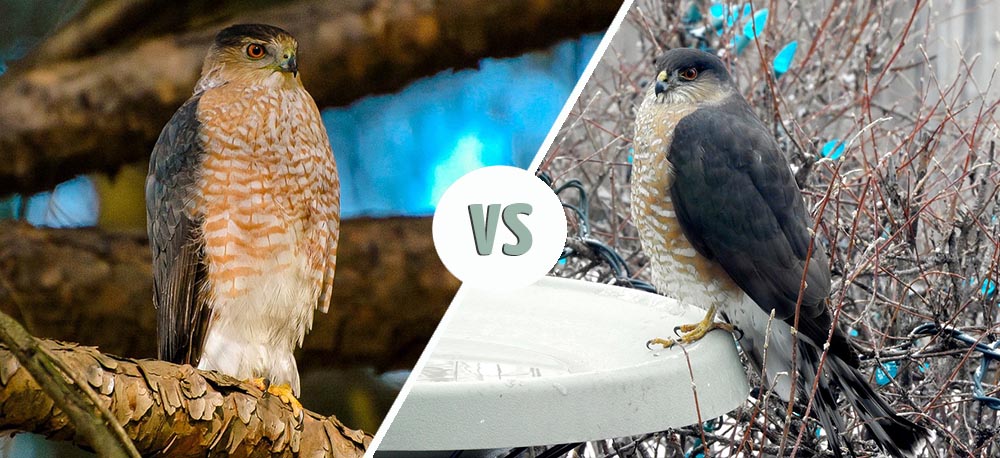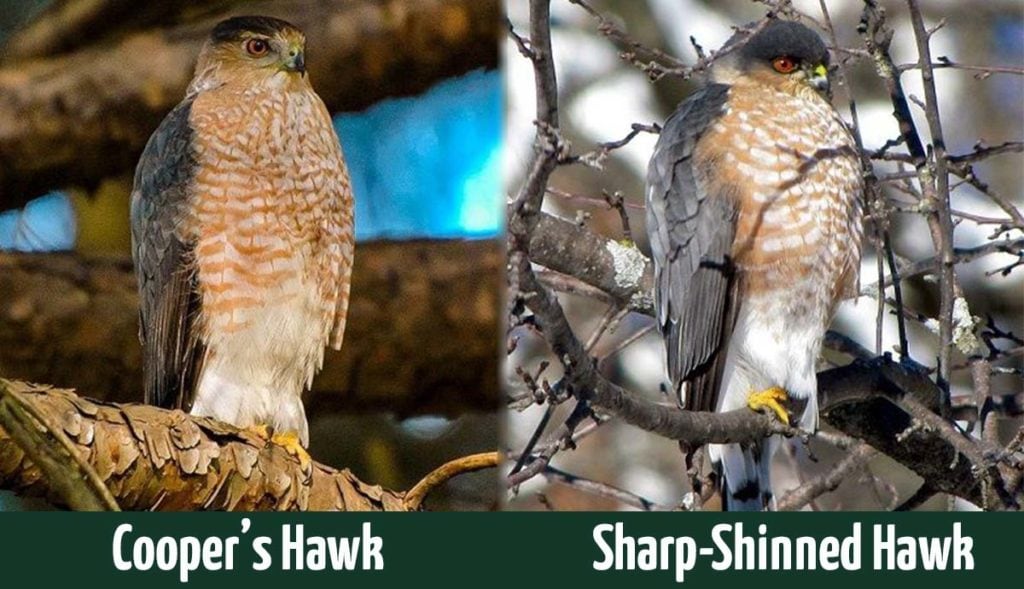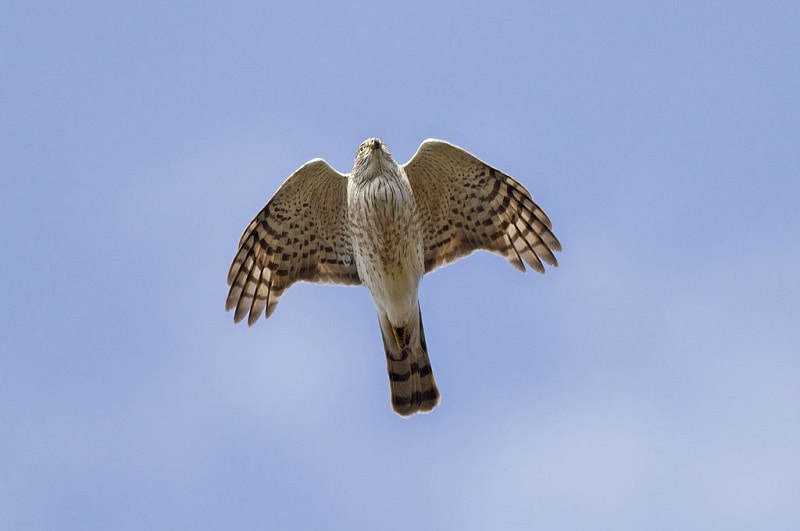Cooper’s Hawks vs Sharp-Shinned Hawks: What’s the Difference?
Last Updated on

When it comes to the Cooper’s Hawk and the Sharp-shinned Hawk, they have many things in common while also being unique. Their colors are almost identical, making it hard to figure out which one you are looking at in the wild. There is one very clear difference, though. Cooper’s Hawks are bigger and you’ll see that moving on. Both birds behave differently around people, too!
As you’ll see the Cooper’s Hawk is the braver of the two species of bird. People do not scare this bird easily, but the Sharp-shinned Hawk would prefer to stay away.
Let’s look at the two birds of prey.

Visual Differences

At a Glance
- Average height (adult): 6–17.7 inches
- Average weight (adult): 8–24 ounces
- Wingspan: 4–35.4 inches
- Clutch Size: 2–6 Eggs
- Habitat: Wooded areas
- Conservation Status: Stable
- Coloring: Steely blue-gray with warm reddish bars
- Range: Across the United States
- Average height (adult): 4–13.4 inches
- Average weight (adult): 1–7.7 ounces
- Wingspan: 9–22.1 inches
- Clutch Size: 3–8 Eggs
- Habitat: Deep forests
- Conservation Status: Yes
- Coloring: Blue-gray with cream chests
- Range: Across North America and Central America

Copper’s Hawks Overview
Behavior
Copper’s Hawks have adapted to people moving into their territory surprisingly well. These birds prefer woodlands for both hunting and nesting purposes. When Cooper’s Hawks hunt, they hunt by stealth. This makes rodents, songbirds, and small mammals prime targets for this bird.
When you see a Cooper’s Hawk fly, they have a distinct pattern. They will typically flap their wings three times, then glide for a distance before flapping again. When hunting, they speed up considerably to swoop down and snatch their meal with their talons.

The courtship of these birds is slow. Both sexes will fly over a territory with slow exaggerated wingbeats till it catches the attention. From there the male will do all the hunting for the female for up to a month before she lays eggs. Both will make the nest together from sticks, bark, grass, and even leaves.
Backyard Tips
Birdseed is going to attract the attention of the Cooper’s Hawk. Bird feeders are going to be a hotspot for this hawk to catch an easy meal. Meaning if you see your songbirds being pecked off then you know you have this hawk around. To combat this, take your feeders down for a few days. The hawk will realize that there is no longer an easy meal and move on. However, don’t be surprised if they come back once you put the feeder up. It is a constant battle to get them to stay away from your feeders.
Population
The current population for these birds is between one-hundred thousand and one million across the North American continent. These birds have suffered population wise in the past because of shootings back in the 1930s and then later the widespread use of organochlorine pesticides, including DDT. Since the ban on DDT in 1972, the population has been rising steadily.
Where to See a Cooper’s Hawk
This hawk spends most of its life all across the United States. They don’t have a preference for climate as long as there is food. When it comes to breeding, they travel north into the upper states and Canada. These birds are more suitable for people to find than other hawk breeds.

Sharp-Shinned Hawk Overview
Behavior
With the small but mighty Sharp-shinned hawk, they are more solitary creatures. Often, they travel alone and hunt alone. These hawks are known as pursuit hunters, meaning they will surprise their prey. Popping out of a hidden perch with a rush of speed, swooping down from perches as little as 3 feet, and bursting from a bush are all tactics of this bird.

These hawks are agile and acrobatic fliers because of their small size. They navigate dense woods at high speeds by using their long tail as a rudder. In vast open areas they fly low to the ground, hugging the contours to rain hidden until the last moment.
When breeding season comes around, they pair up. When paired, the couple take to hiding under the deep forest cover to avoid being eaten by the larger Northern Goshawk. However, it isn’t uncommon to see a small migration of this hawk to appear bigger so they don’t get eaten.
Backyard Tips
Backyard bird feeders can attract Sharp-shinned Hawks every so often. Many bird watchers would prefer this to not happen, but that is the way nature is. There have been studies done that a feeder doesn’t increase the risk of it being taken by this hawk, though. However, if you see one, there is an easy fix if you don’t want to watch the circle of life. Take the feeder down for a couple of weeks to a month and the hawk will move on. The songbirds in the area will return, but the hawk will be long gone.
Population
As of 2015, the Sharp-shinned Hawk has remained stable. Because these birds are solitary and hide their breeding sites, it is hard for scientist to know how well the population is really doing. From a migration standpoint, though, the population spends about 49% of its time in the United States.
The Puerto Rican Sharp-shinned Hawk is federally listed as endangered, though.
Like the larger birds of prey, this hawk suffered when DDT was popular in use. There are still reports of there being high levels of DDT in these birds. The most logical reason is when they migrate south into South America, the use of DDT isn’t banned. It seems to be on the downfall though, as more hawks are spending winters in the southern United States.
Where to See a Sharp-shinned Hawk
These birds are more suited towards the northwest half of the United States. That is where they stay most of the year. Throughout the year, though, they can be found all across the United States. When breeding, they head up into the icy cold of upper Canada and Alaska.

The Difference is Clear
These two majestic birds do share some similarities. They share the same coloring and range, but when you look at them side by side, you see how different they are. The Cooper’s Hawk has adapted to people entering their territory while the Sharp-shinned Hawk has shied away from humans. Both birds and stunning, and now you know more about them.
You might also be interested in some of our top-trending posts:
- Male vs. Female Red-tailed Hawks: Spotting the Differences
- Low-Glow vs No-Glow Trail Cameras: Which to Choose?
- How to Use a Spotting Scope for Birding (4 Helpful Tips)
Featured Image Credit: (L) SK_Zurcher, Pixabay | (R) dbadry, Pixabay
About the Author Robert Sparks
Robert’s obsession with all things optical started early in life, when his optician father would bring home prototypes for Robert to play with. Nowadays, Robert is dedicated to helping others find the right optics for their needs. His hobbies include astronomy, astrophysics, and model building. Originally from Newark, NJ, he resides in Santa Fe, New Mexico, where the nighttime skies are filled with glittering stars.
Related Articles:
How to Clean a Refractor Telescope: Step-by-Step Guide
How to Clean a Telescope Eyepiece: Step-by-Step Guide
How to Clean a Rifle Scope: 8 Expert Tips
Monocular vs Telescope: Differences Explained (With Pictures)
What Is a Monocular Used For? 8 Common Functions
How to Clean a Telescope Mirror: 8 Expert Tips
Brightfield vs Phase Contrast Microscopy: The Differences Explained
SkyCamHD Drone Review: Pros, Cons, FAQ, & Verdict

